Reviewing Value Creation in Agriculture—A Conceptual Analysis and a New Framework
Abstract
:1. Introduction
2. Background
2.1. Business Sustainability and Sustainable Value
2.2. Value in Agricultural Business
3. Methods
4. Results
4.1. Content Analysis
4.1.1. Collaboration
4.1.2. Diversification
4.1.3. Communication
4.1.4. Knowledge
- Information technology skills—a farmer requires at least a basic understanding of IT
- Engagement—farmers should actively engage with the system, e.g., in order to see new opportunities that individual animal data can provide
- Knowledge exchange—information about the system should flow between users and system database
4.1.5. Production
4.1.6. Funding
4.1.7. Policies
4.1.8. Entrepreneurism
4.1.9. Inclusiveness
5. A New Framework for Sustainable Value Creation in Agriculture
Re-thinking Value Creation
6. Conclusions
Author Contributions
Funding
Acknowledgments
Conflicts of Interest
References
- Vargo, S.L.; Maglio, P.P.; Akaka, M.A. On value and value co-creation: A service systems and service logic perspective. Eur. Manag. J. 2008, 26, 145–152. [Google Scholar] [CrossRef]
- Lepak, D.P.; Smith, K.G.; Taylor, M.S. Value Creation and Value Capture: A Multilevel Perspective. Acad. Manag. Rev. 2007, 32, 180–194. [Google Scholar] [CrossRef] [Green Version]
- Brandenburger, A.M.; Stuart, H.W. Value-based Business Strategy. J. Econ. Manag. Strategy 1996, 5, 5–24. [Google Scholar] [CrossRef]
- Peteraf, M.A.; Barney, J.B. Unraveling the resource-based tangle. Manag. Decis. Econ. 2003, 24, 309–323. [Google Scholar] [CrossRef]
- Helfat, C.E.; Finkelstein, S.; Mitchell, W.; Peteraf, M.; Singh, H.; Teece, D.; Winter, S.G. Dynamic Capabilities: Understanding Strategic Change in Organizations; John Wiley & Sons: Hoboken, NJ, USA, 2009; ISBN 978-1-4051-8206-5. [Google Scholar]
- Teece, D.J. Profiting from technological innovation: Implications for integration, collaboration, licensing and public policy. Res. Policy 1986, 15, 285–305. [Google Scholar] [CrossRef]
- Brandenburger, A.M.; Nalebuff, B. The Right Game: Use Game Theory to Shape Strategy. Available online: https://hbr.org/1995/07/the-right-game-use-game-theory-to-shape-strategy (accessed on 3 January 2018).
- Christos, N. Pitelis The Co-Evolution of Organizational Value Capture, Value Creation and Sustainable Advantage. Organ. Stud. 2009, 30, 1115–1139. [Google Scholar] [CrossRef]
- Rainey, D.L. Sustainable Business Development: Inventing the Future Through Strategy, Innovation, and Leadership; Cambridge University Press: Cambridge, UK, 2006. [Google Scholar]
- Elkington, J. Cannibals with Forks: The Triple Bottom Line of 21st Century Business; New Society Publishers: Gabriola, BC, Canada, 1998; ISBN 978-0-86571-392-5. [Google Scholar]
- World Economic Forum Innovation with a Purpose: Strengthening Food Systems through Technology. Available online: https://www.weforum.org/projects/innovation-with-a-purpose-strengthening-food-systems-through-technology (accessed on 17 June 2020).
- Hart, S.L.; Milstein, M.B. Creating sustainable value. Acad. Manag. Exec. 2003, 17, 56–67. [Google Scholar] [CrossRef]
- Jensen, P.A. The Facilities Management Value Map: A conceptual framework. Facilities 2010, 28, 175–188. [Google Scholar] [CrossRef]
- Bowman, C.; Ambrosini, V. Value Creation Versus Value Capture: Towards a Coherent Definition of Value in Strategy. Br. J. Manag. 2000, 11, 1–15. [Google Scholar] [CrossRef]
- Priem, R.L. A Consumer Perspective on Value Creation. Acad. Manag. Rev. 2007, 32, 219–235. [Google Scholar] [CrossRef]
- Sirmon, D.G.; Hitt, M.A.; Ireland, R.D. Managing Firm Resources in Dynamic Environments to Create Value: Looking Inside the Black Box. Acad. Manag. Rev. 2007, 32, 273–292. [Google Scholar] [CrossRef] [Green Version]
- Porter, M.E. Competitive Strategy: Techniques for Analyzing Industries and Competitors; Free Press: New York, NY, USA, 1980. [Google Scholar]
- Kordupleski, R. Mastering Customer Value Management: The Art and Science of Creating Competitive Advantage; Pinnaflex Educational Resources Inc.: Columbus, OH, USA, 2003; ISBN 978-1-893673-07-6. [Google Scholar]
- Steurer, R.; Langer, M.E.; Konrad, A.; Martinuzzi, A. Corporations, Stakeholders and Sustainable Development I: A Theoretical Exploration of Business—Society Relations. J. Bus. Ethics 2005, 61, 263–281. [Google Scholar] [CrossRef]
- Dyllick, T.; Hockerts, K. Beyond the business case for corporate sustainability. Bus. Strategy Environ. 2002, 11, 130–141. [Google Scholar] [CrossRef]
- Gladwin, T.N.; Kennelly, J.J.; Krause, T.-S. Shifting paradigms for sustainable development: Implications for management theory and research. Acad. Manag. Rev. 1995, 20, 874–907. [Google Scholar] [CrossRef] [Green Version]
- Porter, M.E.; Kramer, M.R. Creating Shared Value. In Managing Sustainable Business: An Executive Education Case and Textbook; Lenssen, G.G., Smith, N.C., Eds.; Springer: Dordrecht, The Netherlands, 2019; pp. 323–346. ISBN 978-94-024-1144-7. [Google Scholar]
- Morioka, S.N.; Bolis, I.; Carvalho, M.M.D. From an ideal dream towards reality analysis: Proposing Sustainable Value Exchange Matrix (SVEM) from systematic literature review on sustainable business models and face validation. J. Clean. Prod. 2018, 178, 76–88. [Google Scholar] [CrossRef]
- Coltrain, D.; Barton, D.; Boland, M. Value Added: Opportunities and Strategies; Arthur Capper Cooperative, Center Department of Agricultural Economics, Cooperative Extension Service, Kansas State University: Manhattan, KS, USA, 2000. [Google Scholar]
- Womach, J. Agriculture: A Glossary of Terms, Programs, and Laws, 2005 Edition. Available online: https://digital.library.unt.edu/ark:/67531/metacrs7246/ (accessed on 10 January 2018).
- Amanor-Boadu, V.A. Conversation about Value-Added Agriculture; Value-Added Business Development Program; Department of Agricultural Economics; Kansas State University: Manhattan, KS, USA, 2003. [Google Scholar]
- Ernst and Woods Adding Value to Plant Production: An Overview. Available online: http://www.uky.edu/ccd/marketing/market-resources/v-a/overview (accessed on 10 January 2018).
- Lu, R.; Dudensing, R. What Do We Mean by Value-added Agriculture? Choices 2015, 30, 316–2016–7795. [Google Scholar]
- USDA Value Added Producer Grants | USDA Rural Development. Available online: https://www.govinfo.gov/content/pkg/FR-2015-05-08/pdf/2015-10441.pdf (accessed on 28 September 2019).
- Rowley, J.; Slack, F. Conducting a literature review. Manag. Res. News 2004, 27, 31–39. [Google Scholar] [CrossRef]
- Tranfield, D.; Denyer, D.; Smart, P. Towards a Methodology for Developing Evidence-Informed Management Knowledge by Means of Systematic Review. Br. J. Manag. 2003, 14, 207–222. [Google Scholar] [CrossRef]
- Seuring, S.; Müller, M. From a literature review to a conceptual framework for sustainable supply chain management. J. Clean. Prod. 2008, 16, 1699–1710. [Google Scholar] [CrossRef]
- Moher, D.; Shamseer, L.; Clarke, M.; Ghersi, D.; Liberati, A.; Petticrew, M.; Shekelle, P.; Stewart, L.A. PRISMA-P Group Preferred reporting items for systematic review and meta-analysis protocols (PRISMA-P) 2015 statement. Syst. Rev. 2015, 4, 1. [Google Scholar] [CrossRef] [Green Version]
- Bandara, W.; Miskon, S.; Fielt, E. A systematic, tool-supported method for conducting literature reviews in information systems. In Proceedings of the Proceedings of the 19th European Conference on Information Systems (ECIS 2011), Helsinki, Finland, 9–11 June 2011. [Google Scholar]
- Laplume, A.O.; Sonpar, K.; Litz, R.A. Stakeholder theory: Reviewing a theory that moves us. J. Manag. 2008, 34, 1152–1189. [Google Scholar] [CrossRef]
- Eastwood, C.R.; Chapman, D.F.; Paine, M.S. Networks of practice for co-construction of agricultural decision support systems: Case studies of precision dairy farms in Australia. Agric. Syst. 2012, 108, 10–18. [Google Scholar] [CrossRef]
- Nettle, R.; Brightling, P.; Hope, A. How Programme Teams Progress Agricultural Innovation in the Australian Dairy Industry. J. Agric. Educ. Ext. 2013, 19, 271–290. [Google Scholar] [CrossRef]
- Thilmany, D.D.; Umberger, W.J.; Ziehl, A.R. Strategic market planning for value-added natural beef products: A cluster analysis of Colorado consumers. Renew. Agric. Food Syst. 2006, 21, 192–203. [Google Scholar] [CrossRef] [Green Version]
- Armstrong, G.; Farley, H.; Gray, J.; Durkin, M. Marketing health-enhancing foods: Implications from the dairy sector. Mark. Intell. Plan. 2005, 23, 705–719. [Google Scholar] [CrossRef]
- Higgins, A.J.; Laredo, L.A. Improving Harvesting and Transport Planning within a Sugar Value Chain. J. Oper. Res. Soc. 2006, 57, 367–376. [Google Scholar] [CrossRef]
- Sogn-Grundvag, G.; Larsen, T.A.; Young, J.A. Product differentiation with credence attributes and private labels: The case of whitefish in UK supermarkets. J. Agric. Econ. 2014, 65, 368–382. [Google Scholar] [CrossRef]
- Deselnicu, O.C.; Costanigro, M.; Souza-Monteiro, D.M.; McFadden, D.T. A Meta-Analysis of Geographical Indication Food Valuation Studies: What Drives the Premium for Origin-Based Labels? J. Agric. Resour. Econ. 2013, 38. [Google Scholar]
- Anic, I.-D.; Nusinovic, M. The apple industry in Croatia: A value chain analysis approach. Int. J. Entrep. Small Bus. 2005, 2, 211–225. [Google Scholar] [CrossRef]
- Atănăsoaie, G. Distribution channels on the organic foods market. J. Hortic. For. Biotechnol. 2011, 15, 19–25. [Google Scholar]
- Austin, J.E.; Leonard, H.B. Can the virtuous mouse and the wealthy elephant live happily ever after? Calif. Manag. Rev. 2008, 51, 77–102. [Google Scholar] [CrossRef]
- Badar, H.; Ariyawardana, A.; Collins, R. Capturing Consumer Preferences for Value Chain Improvements in the Mango Industry of Pakistan. Available online: https://ageconsearch.umn.edu/record/208498 (accessed on 13 January 2019).
- Baron, D.P. Credence attributes, voluntary organizations, and social pressure. J. Public Econ. 2011, 95, 1331–1338. [Google Scholar] [CrossRef]
- Batterink, M.H.; Wubben, E.F.M.; Klerkx, L.; Omta, S.W.F. (Onno) Orchestrating innovation networks: The case of innovation brokers in the agri-food sector. Entrep. Reg. Dev. 2010, 22, 47–76. [Google Scholar] [CrossRef]
- Bertazzoli, A.; Fiorini, A.; Ghelfi, R.; Rivaroli, S.; Samoggia, A.; Mazzotti, V. Food Chains and Value System: The Case of Potato, Fruit, and Cheese. J. Food Prod. Mark. 2011, 17, 303–326. [Google Scholar] [CrossRef]
- Boehlje, M. Business challenges in commercialization of agricultural technology. Int. Food Agribus. Manag. Rev. 2004, 7, 91. [Google Scholar]
- Bogale, S.A.; Verhees, F.J.; Trijp, H.C. van Customer Evaluation of Supply Systems: The Case of Ethiopian Seed Supply Systems. J. Afr. Bus. 2018, 19, 550–570. [Google Scholar] [CrossRef]
- Boland, M.A. Cargill: Biotechnology and Value Creation in Wheat. Available online: https://ageconsearch.umn.edu/record/34397 (accessed on 14 January 2019).
- Bongiovanni, R.; Lowenberg-Deboer, J. Precision Agriculture and Sustainability. Precis. Agric. 2004, 5, 359–387. [Google Scholar] [CrossRef]
- Bonney, L.; Collins, R.; Miles, M.P.; Verreynne, M.-L. A note on entrepreneurship as an alternative logic to address food security in the developing world. J. Dev. Entrep. 2013, 18, 1350016. [Google Scholar] [CrossRef] [Green Version]
- Bramley, C.; Kirsten, J.F. Exploring the economic rationale for protecting geographical indicators in agriculture. Agrekon 2007, 46, 69–93. [Google Scholar] [CrossRef]
- Briscoe, R.; Ward, M. In Small Both Beautiful and Competitive? A Case Study of Irish Dairy Cooperatives. J. Rural Coop. 2006, 34, 119–138. [Google Scholar]
- Bryla, P. Creating and Delivering Value for Consumers of Healthy Food–a Case Study of Organic Farma Zdrowia SA. J. Manag. Bus. Adm. Cent. Eur. 2017, 25, 55–74. [Google Scholar]
- Campbell, D.; Doherty, E. Combining discrete and continuous mixing distributions to identify niche markets for food. Eur. Rev. Agric. Econ. 2013, 40, 287–312. [Google Scholar] [CrossRef]
- Carriquiry, M.; Babcock, B.A. Reputations, market structure, and the choice of quality assurance systems in the food industry. Am. J. Agric. Econ. 2007, 89, 12–23. [Google Scholar] [CrossRef]
- Che, D. Developing ecotourism in First World, resource-dependent areas. Geoforum 2006, 37, 212–226. [Google Scholar] [CrossRef]
- Chen, Y.-J.; Tang, C.S. The Economic Value of Market Information for Farmers in Developing Economies. Prod. Oper. Manag. 2015, 24, 1441–1452. [Google Scholar] [CrossRef]
- Chumaidiyah, E. Value Chain Map of Small Agricultural Product-Processing Enterprises in Bandung, Indonesia. Int. J. Supply Chain Manag. 2017, 6, 76–82. [Google Scholar]
- Cloesen, U. Entrepreneurship within rural tourism: A private walkway on Banks Peninsula, New Zealand. Turiz. Med. Junarodni Znan. Stručni Časopis 2007, 55, 81–91. [Google Scholar]
- Cucagna, M.E.; Goldsmith, P.D. Value adding in the agri-food value chain. Int. Food Agribus. Manag. Rev. 2018, 21, 293–316. [Google Scholar] [CrossRef]
- Darroch, M.A.; Akridge, J.T.; Boehlje, M.D. Capturing value in the supply chain: The case of high oleic acid soybeans. Int. Food Agribus. Manag. Rev. 2002, 5, 87–103. [Google Scholar] [CrossRef]
- Dentoni, D.; Hospes, O.; Ross, R.B. Managing wicked problems in agribusiness: The role of multi-stakeholder engagements in value creation: Editor’s Introduction. Int. Food Agribus. Manag. Rev. 2012, 15, 1–12. [Google Scholar]
- De Carvalho, B.R.P.; Mendes, H. Cashew Chain Value in Guiné-Bissau: Challenges and Contributions for Food Security: A Case Study for Guiné-Bissau. Int. J. Food Syst. Dyn. 2016, 7, 1–13. [Google Scholar]
- Declerck, F.; Cloutier, L.M. The financial value of corporations in a cobweb economy: Champagne industry dynamics. Int. J. Wine Bus. Res. 2010, 22, 269–287. [Google Scholar] [CrossRef]
- Dey, B.L.; Pandit, A.; Saren, M.; Bhowmick, S.; Woodruffe-Burton, H. Co-creation of value at the bottom of the pyramid: Analysing Bangladeshi farmers’ use of mobile telephony. J. Retail. Consum. Serv. 2016, 29, 40–48. [Google Scholar] [CrossRef]
- Di Gregorio, D. Place-based business models for resilient local economies: Cases from Italian slow food, agritourism and the albergo diffuso. J. Enterp. Communities People Places Glob. Econ. 2017, 11, 113–128. [Google Scholar] [CrossRef]
- Duffy, R.; Fearne, A. Buyer-Supplier Relationships: An Investigation of Moderating Factors on the Development of Partnership Characteristics and Performance. Available online: https://ageconsearch.umn.edu/record/8116 (accessed on 13 January 2019).
- Fafchamps, M.; Minten, B. Returns to social network capital among traders. Oxf. Econ. Pap. 2002, 54, 173–206. [Google Scholar] [CrossRef]
- Ferraz, L.Z.T.; Rezende, A.J.; Lima, J.P.R.D.; Todeva, E. Perception of Value Co-creation Actions in Agricultural Cooperatives. Braz. Adm. Rev. 2018, 15. [Google Scholar] [CrossRef]
- Giannakis, E.; Bruggeman, A. The highly variable economic performance of European agriculture. Land Use Policy 2015, 45, 26–35. [Google Scholar] [CrossRef]
- Gloy, B.A.; Akridge, J.T. Computer and internet adoption on large US farms. Int. Food Agribus. Manag. Rev. 2000, 3, 323–338. [Google Scholar] [CrossRef]
- Gray, A.; Boehlje, M.; Amanor-Boadu, V.; Fulton, J. Agricultural Innovation and New Ventures: Assessing the Commercial Potential. Am. J. Agric. Econ. 2004, 86, 1322–1329. [Google Scholar] [CrossRef]
- Goldsmith, P.; Bender, K. Ten conversations about identity preservation. J. Chain Netw. Sci. 2004, 4, 111–123. [Google Scholar] [CrossRef]
- Goldsmith, P.; Gow, H. Strategic Positioning Under Agricultural Structural Change: A Critique of Long Jump Co-operative Ventures. Int. Food Agribus. Manag. Rev. 2005, 8, 22. [Google Scholar]
- Grunert, K.G.; Jeppesen, L.F.; Jespersen, K.R.; Sonne, A.-M.; Hansen, K.; Trondsen, T.; Young, J.A. Market orientation of value chains: A conceptual framework based on four case studies from the food industry. Eur. J. Mark. 2005, 39, 428–455. [Google Scholar] [CrossRef]
- Hall, A. Capacity development for agricultural biotechnology in developing countries: An innovation systems view of what it is and how to develop it. J. Int. Dev. 2005, 17, 611–630. [Google Scholar] [CrossRef]
- Hsu, S.-M.; Hsieh, P.-H.; Yuan, S.-T. Roles of ‘small- and medium-sized enterprises’ in service industry innovation: A case study on leisure agriculture service in tourism regional innovation. Serv. Ind. J. 2013, 33, 1068–1088. [Google Scholar] [CrossRef]
- Han, I.; Chuang, C.-M. The antecedents and consequences of local embeddedness: A framework based on the rice industry in Taiwan. Asian Bus. Manag. 2015, 14, 195–226. [Google Scholar] [CrossRef]
- Handayati, Y.; Simatupang, T.M.; Perdana, T. Agri-food supply chain coordination: The state-of-the-art and recent developments. Logist. Res. 2015, 8, 5. [Google Scholar] [CrossRef] [Green Version]
- Hartlieb, S.; Jones, B. Humanising Business Through Ethical Labelling: Progress and Paradoxes in the UK. J. Bus. Ethics 2009, 88, 583–600. [Google Scholar] [CrossRef]
- Hastings, K.; Howieson, J.; Lawley, M. Creating value chains: The role of relationship development. Br. Food J. 2016, 118, 1384–1406. [Google Scholar] [CrossRef]
- Hinrichs, C.C. Embeddedness and local food systems: Notes on two types of direct agricultural market. J. Rural. Stud. 2000, 16, 295–303. [Google Scholar] [CrossRef]
- Hinterhuber, A. Value chain orchestration in action and the case of the global agrochemical industry. Long Range Plan. 2002, 35, 615–635. [Google Scholar] [CrossRef]
- Howieson, J.; Lawley, M.; Hastings, K. Value chain analysis: An iterative and relational approach for agri-food chains. Supply Chain Manag. Int. J. 2016, 21, 352–362. [Google Scholar] [CrossRef]
- Hunt, D.M.; Geiger-Oneto, S.; Varca, P.E. Satisfaction in the context of customer co-production: A behavioral involvement perspective. J. Consum. Behav. 2012, 11, 347–356. [Google Scholar] [CrossRef]
- Jayashankar, P.; Nilakanta, S.; Johnston, W.J.; Gill, P.; Burres, R. IoT adoption in agriculture: The role of trust, perceived value and risk. J. Bus. Ind. Mark. 2018, 33, 804–821. [Google Scholar] [CrossRef]
- Jayashankar, P.; Van Auken, H.; Ashta, A. What motivates ecopreneurs in the United States to create value? Strateg. Chang 2018, 27, 509–521. [Google Scholar] [CrossRef]
- Jraisat, L. A network perspective and value added tasks: The case of agri-food value chain. Asia Pac. J. Mark. Logist. 2016, 28, 350–365. [Google Scholar] [CrossRef]
- Jolink, A.; Niesten, E. Sustainable development and business models of entrepreneurs in the organic food industry. Bus. Strategy Environ. 2015, 24, 386–401. [Google Scholar] [CrossRef]
- Kaaristo, M. Value of silence: Mediating aural environments in Estonian rural tourism. J. Tour. Cult. Chang 2014, 12, 267–279. [Google Scholar] [CrossRef]
- Kastelli, I.; Tsakanikas, A.; Caloghirou, Y. Technology transfer as a mechanism for dynamic transformation in the food sector. J. Technol. Transf. 2018, 43, 882–900. [Google Scholar] [CrossRef]
- Katz, J.P.; Boland, M.A. One for All and All for One? A New Generation of Co-operatives Emerges. Long Range Plan. 2002, 35, 73–89. [Google Scholar] [CrossRef]
- Kline, C.; Boluk, K.; Shah, N.M. Exploring social entrepreneurship in food tourism. In Social Entrepreneurship and Tourism; Springer: Berlin, Germany, 2017; pp. 135–154. [Google Scholar]
- Leguizamon, F.; Selva, G.; Santos, M. Small farmer suppliers from local to global. J. Bus. Res. 2016, 69, 4520–4525. [Google Scholar] [CrossRef]
- Liang, A.R.-D. Considering the role of agritourism co-creation from a service-dominant logic perspective. Tour. Manag. 2017, 61, 354–367. [Google Scholar] [CrossRef]
- London, T.; Anupindi, R.; Sheth, S. Creating mutual value: Lessons learned from ventures serving base of the pyramid producers. J. Bus. Res. 2010, 63, 582–594. [Google Scholar] [CrossRef]
- Lutkemeyer Filho, M.G.; RoeheVaccaro, G.L.; Freitas, E.C. de Identification of customer satisfaction in services: A study on agribusiness dealers. Rev. Bras. Gest. Neg. 2015, 17, 1408–1425. [Google Scholar]
- Marotta, G.; Nazzaro, C.; Stanco, M. How the social responsibility creates value: Models of innovation in Italian pasta industry. Int. J. Glob. Small Bus. 2017, 9, 144–167. [Google Scholar] [CrossRef]
- Matopoulos, A.; Vlachopoulou, M.; Manthou, V.; Manos, B. A conceptual framework for supply chain collaboration: Empirical evidence from the agri-food industry. Supply Chain Manag. Int. J. 2007, 12, 177–186. [Google Scholar] [CrossRef] [Green Version]
- McBratney, A.; Whelan, B.; Ancev, T.; Bouma, J. Future Directions of Precision Agriculture. Precis. Agric. 2005, 6, 7–23. [Google Scholar] [CrossRef]
- Melton, B.E.; Huffman, W.E. Beef and Pork Packing Costs and Input Demands: Effects of Unionization and Technology. Am. J. Agric. Econ. 1995, 77, 471–485. [Google Scholar] [CrossRef]
- Mishra, A.; Wilson, C.; Williams, R. Factors affecting financial performance of new and beginning farmers. Agric. Financ. Rev. 2009, 69, 160–179. [Google Scholar] [CrossRef]
- Moeen, M.; Agarwal, R. Incubation of an industry: Heterogeneous knowledge bases and modes of value capture. Strateg. Manag. J. 2017, 38, 566–587. [Google Scholar] [CrossRef]
- Menozzi, D. Extra-virgin olive oil production sustainability in northern Italy: A preliminary study. Br. Food J. 2014, 116, 1942–1959. [Google Scholar] [CrossRef]
- Meissner, F.; Komba, X.K. Balanced growth through local entrepreneurship: The Komba coffee project in southern Tanzania. In Balanced Growth; Springer: Berlin, Germany, 2012; pp. 183–193. [Google Scholar]
- MK Leat, P.; Revoredo-Giha, C. In search of differentiation and the creation of value: The quest of the Scottish pig supply chain. Br. Food J. 2013, 115, 1487–1504. [Google Scholar] [CrossRef]
- Migliore, G.; Schifani, G.; Cembalo, L. Opening the black box of food quality in the short supply chain: Effects of conventions of quality on consumer choice. Food Qual. Prefer. 2015, 39, 141–146. [Google Scholar] [CrossRef]
- Micheels, E.T.; Gow, H.R. Do market oriented firms demonstrate clarity on their value discipline? Evidence from Illinois beef producers. Int. Food Agribus. Manag. Rev. 2009, 12, 127. [Google Scholar]
- Montealegre, F.; Thompson, S.R.; Eales, J.S. An Empirical Analysis of the Determinants of Success of Food and Agribusiness E-Commerce Firms. Available online: https://ageconsearch.umn.edu/record/8168 (accessed on 13 January 2019).
- Moulton, K.S.; Zwane, A.P. Managing Environmental Risks through Private Sector Cooperation: Cooperation: Theory, Experience and a Case Study of the California Code of Sustainable Winegrowing Practices. Available online: https://ageconsearch.umn.edu/record/8131 (accessed on 13 January 2019).
- Munjal, S.; Sharma, S.; Menon, P. Moving towards “Slow Food”, the new frontier of culinary innovation in India: The Vedatya experience. Worldw. Hosp. Tour. Themes 2016, 8, 444–460. [Google Scholar] [CrossRef]
- Neganova, I.S. Managing core competences to create value for customers. World Rev. Entrep. Manag. Sustain. Dev. 2010, 6, 304–317. [Google Scholar] [CrossRef]
- Pannekoek, L.; van Kooten, O.; Kemp, R.; Omta, S. Entrepreneurial innovation in chains and networks in Dutch greenhouse horticulture. J. Chain Netw. Sci. 2005, 5, 39–50. [Google Scholar] [CrossRef]
- Pant, L.P.; Hambly-Odame, H.; Hall, A.; V, R.S. Beyond the supply chains of technology and commodity: Challenges to strengthening mango innovation systems in Andhra Pradesh, India. World J. Sci. Technol. Sustain. Dev. 2012, 9, 175–193. [Google Scholar] [CrossRef]
- Pascucci, S.; Magistris, T. de Information Bias Condemning Radical Food Innovators? The Case of Insect-Based Products in the Netherlands. Available online: https://ageconsearch.umn.edu/record/156421 (accessed on 13 June 2019).
- Patel, D.M. The Export Trading Group: Unlocking Africa’s Agricultural Potential. Int. Food Agribus. Manag. Rev. 2014, 17, 187. [Google Scholar]
- Pennings, J. Commodity futures markets as drivers of agriculture and agribusinesses in developing countries: What needs to be done? Mark. Mark. 2010. [Google Scholar]
- Peterson, H.C. Fundamental Principles of Managing Multi-Stakeholder Engagement. Available online: https://ageconsearch.umn.edu/record/155141 (accessed on 13 June 2019).
- Polo Redondo, Y.; Cambra Fierro, J.J. Importance of company size in long-term orientation of supply function: An empirical research. J. Bus. Ind. Mark. 2007, 22, 236–248. [Google Scholar] [CrossRef]
- Poniman, D.; Purchase, S.; Sneddon, J. Traceability systems in the Western Australia halal food supply chain. Asia Pac. J. Mark. Logist. 2015, 27, 324–348. [Google Scholar] [CrossRef]
- Ramesh, G. Mainstreaming an unorganized industry: The case of Suguna poultry. Vikalpa 2010, 35, 35–48. [Google Scholar] [CrossRef] [Green Version]
- Ruslan, N.A.; Man, N.; Nawi, N.M.; Ding, P. Factors That Influence the Implementation of Postharvest Handling Practices Among Fresh Vegetable Producers in Selected States in Malaysia. J. Int. Food Agribus. Mark. 2013, 25, 87–97. [Google Scholar] [CrossRef]
- Safri, M. Mapping noncapitalist supply chains: Toward an alternate conception of value creation and distribution. Organization 2015, 22, 924–941. [Google Scholar] [CrossRef]
- Shah, S.; Ghazzawi, I.A. Bc Frozen Foods Limited: Challenges and Change1. J. Int. Acad. Case Stud. 2012, 18, 1. [Google Scholar]
- Semenda, D.K.; Semenda, O.V.; Gvozdiei, N.I. ANALYSIS OF TAX ENVIRONMENT OF BUSINESS IN AGRARIAN SECTOR OF ECONOMY OF UKRAINE. Financ. Credit Act. Probl. Theory Pract. 2018, 2, 148–156. [Google Scholar] [CrossRef] [Green Version]
- Sexton, R.J.; Sheldon, I.; McCorriston, S.; Wang, H. Agricultural trade liberalization and economic development: The role of downstream market power. Agric. Econ. 2007, 36, 253–270. [Google Scholar] [CrossRef]
- Shieh, C.-J.; Hu, R. Evaluating business performance of agricultural cooperation groups with Data Envelopment Analysis. Custos E Agronegocio 2016, 12, 2–16. [Google Scholar]
- Sturaro, E.; Marchiori, E.; Cocca, G.; Penasa, M.; Ramanzin, M.; Bittante, G. Dairy systems in mountainous areas: Farm animal biodiversity, milk production and destination, and land use. Livest. Sci. 2013, 158, 157–168. [Google Scholar] [CrossRef]
- Sturiale, L.; Scuderi, A. The digital economy: New e-business strategies for food Italian system. Int. J. Electron. Mark. Retail. 2016, 7, 287–310. [Google Scholar] [CrossRef]
- Starr, A.; Card, A.; Benepe, C.; Auld, G.; Lamm, D.; Smith, K.; Wilken, K. Sustaining local agriculture Barriers and opportunities to direct marketing between farms and restaurants in Colorado. Agric. Hum. Values 2003, 20, 301–321. [Google Scholar] [CrossRef]
- Tampe, M. Leveraging the Vertical: The Contested Dynamics of Sustainability Standards and Labour in Global Production Networks. Br. J. Ind. Relat. 2018, 56, 43–74. [Google Scholar] [CrossRef]
- Tang, C.S.; Sodhi, M.S.; Formentini, M. An analysis of partially-guaranteed-price contracts between farmers and agri-food companies. Eur. J. Oper. Res. 2016, 254, 1063–1073. [Google Scholar] [CrossRef] [Green Version]
- Teklehaimanot, M.L.; Ingenbleek, P.T.M.; Trijp, H.C.M. van The Transformation of African Smallholders into Customer Value Creating Businesses: A Conceptual Framework. J. Afr. Bus. 2017, 18, 299–319. [Google Scholar] [CrossRef]
- Tencati, A.; Zsolnai, L. Collaborative enterprise and sustainability: The case of slow food. J. Bus. Ethics 2012, 110, 345–354. [Google Scholar] [CrossRef]
- Thomas-Francois, K.; Joppe, M.; von Massow, M. Improving linkages through a service-oriented Local farmers–hotel supply chain—An Explanatory case in Grenada. Tour. Plan. Dev. 2018, 15, 398–418. [Google Scholar] [CrossRef]
- Tzouramani, I.; Sintori, A.; Liontakis, A.; Karanikolas, P.; Alexopoulos, G. An assessment of the economic performance of organic dairy sheep farming in Greece. Livest. Sci. 2011, 141, 136–142. [Google Scholar] [CrossRef]
- Uzea, F.N.; Fulton, M.E. Mechanisms for effective alliance management: Insights from a federated cooperative marketing system. Int. Food Agribus. Manag. Rev. 2014, 17, 95. [Google Scholar]
- Woiceshyn, J. Lessons in product innovation: A case study of biotechnology firms. RD Manag. 1995, 25, 395–409. [Google Scholar] [CrossRef]
- Zavorotin, E.F.; Yurkova, M.S.; Serdobintsev, D.V.; Likhovtsova, E.A.; Voloshchuk, L.A. Perfecting the Cluster Development in the Regional Dairy Products Subcomplex of the Russian Agro-Industrial Complex. J. Environ. Manag. Tour. 2018, 9, 947–954. [Google Scholar] [CrossRef]
- Pusporini, P.; Abhary, K.; Luong, L. Intelligent Design of Environmental Performance Evaluation Using Fuzzy Expert System; Trans Tech Publications Ltd.: Stafa-Zurich, Switzerland, 2013; Volume 330. [Google Scholar]
- Gebbers, R.; Adamchuk, V.I. Precision Agriculture and Food Security. Science 2010, 327, 828–831. [Google Scholar] [CrossRef] [PubMed]
- Tóth, J.; Migliore, G.; Schifani, G.; Rizzo, G. Sustainable Value Creation in the Food Chain: A Consumer Perspective. Sustainability 2020, 12, 1438. [Google Scholar] [CrossRef] [Green Version]
- Nogueira, A.; Ashton, W.; Teixeira, C.; Lyon, E.; Pereira, J. Infrastructuring the Circular Economy. Energies 2020, 13, 1805. [Google Scholar] [CrossRef] [Green Version]
- Donner, M.; Gohier, R.; de Vries, H. A new circular business model typology for creating value from agro-waste. Sci. Total Environ. 2020, 716, 137065. [Google Scholar] [CrossRef] [PubMed]
- Shen, N. Customer Knowledge Sharing Incentive Mechanism in Agricultural Products Supply Chain in Big Data Context. Rev. Fac. Agron. Univ. Zulia 2019. [Google Scholar]
- Nazzaro, C.; Stanco, M.; Marotta, G. The Life Cycle of Corporate Social Responsibility in Agri-Food: Value Creation Models. Sustainability 2020, 12, 1287. [Google Scholar] [CrossRef] [Green Version]
- Mendelsohn, R.; Nordhaus, W.; Shaw, D. Climate impacts on aggregate farm value: Accounting for adaptation. Agric. For. Meteorol. 1996, 80, 55–66. [Google Scholar] [CrossRef]
- Ao, X.H.; Vu, T.V.; Le, K.D.; Jirakiattikul, S.; Techato, K. An analysis of the smallholder farmers’ cassava (Manihot esculenta Crantz) value chain through a gender perspective: The case of Dak Lak province, Vietnam. Cogent Econ. Finance 2019, 7, 1645632. [Google Scholar] [CrossRef]
- Dumont, E.S.; Bonhomme, S.; Pagella, T.F.; Sinclair, F.L. Structured stakeholder engagement leads to development of more diverse and inclusive agroforestry options. Exp. Agric. 2019, 55, 252–274. [Google Scholar] [CrossRef] [Green Version]
- Hall, J.K.; Martin, M.J.C. Disruptive technologies, stakeholders and the innovation value-added chain: A framework for evaluating radical technology development. RD Manag. 2005, 35, 273–284. [Google Scholar] [CrossRef]
- Baumgartner, R.J.; Korhonen, J. Strategic thinking for sustainable development. Sustain. Dev. 2010, 18, 71–75. [Google Scholar] [CrossRef]
- Shennan, C. Biotic interactions, ecological knowledge and agriculture. Philos. Trans. R. Soc. B Biol. Sci. 2008, 363, 717–739. [Google Scholar] [CrossRef] [PubMed] [Green Version]
- Knight, J.; Weir, S.; Woldehanna, T. The role of education in facilitating risk-taking and innovation in agriculture. J. Dev. Stud. 2003, 39, 1–22. [Google Scholar] [CrossRef]
- Hult, G.T.M.; Hurley, R.F.; Knight, G.A. Innovativeness: Its antecedents and impact on business performance. Ind. Mark. Manag. 2004, 33, 429–438. [Google Scholar] [CrossRef]
- Ellen MacArthur Foundation. Circular Economy Report—Towards the Circular Economy; Ellen MacArthur Foundation: Cowes, UK, 2014; Volume 3. [Google Scholar]
- European Commission Bioeconomy. Available online: https://ec.europa.eu/programmes/horizon2020/en/h2020-section/bioeconomy (accessed on 29 March 2020).
- Maizza, A.; Fait, M.; Scorrano, P.; Iazzi, A. How Knowledge Sharing Culture Can Become a Facilitator of the Sustainable Development in the Agrifood Sector. Sustainability 2019, 11, 952. [Google Scholar] [CrossRef] [Green Version]
- Dyjakon, A.; García-Galindo, D. Implementing Agricultural Pruning to Energy in Europe: Technical, Economic and Implementation Potentials. Energies 2019, 12, 1513. [Google Scholar] [CrossRef] [Green Version]
- Jayashankar, P.; Johnston, W.J.; Nilakanta, S.; Burres, R. Co-creation of value-in-use through big data technology—A B2B agricultural perspective. J. Bus. Ind. Mark. 2019, 35, 508–523. [Google Scholar] [CrossRef]
- Grabs, J.; Ponte, S. The evolution of power in the global coffee value chain and production network. J. Econ. Geogr. 2019, 19, 803–828. [Google Scholar] [CrossRef]
- Chamberlain, W.O.; Anseeuw, W. Inclusiveness revisited: Assessing inclusive businesses in South African agriculture. Dev. S. Afr. 2019, 36, 600–615. [Google Scholar] [CrossRef] [Green Version]
- Hernandez-Cazares, R.; Lawson-Lartego, L.; Mathiassen, L.; Quinonez-Romandia, S. Strategizing for the bottom of the pyramid: An action research into a Mexican agribusiness. J. Bus. Ind. Mark. 2019. [Google Scholar] [CrossRef]

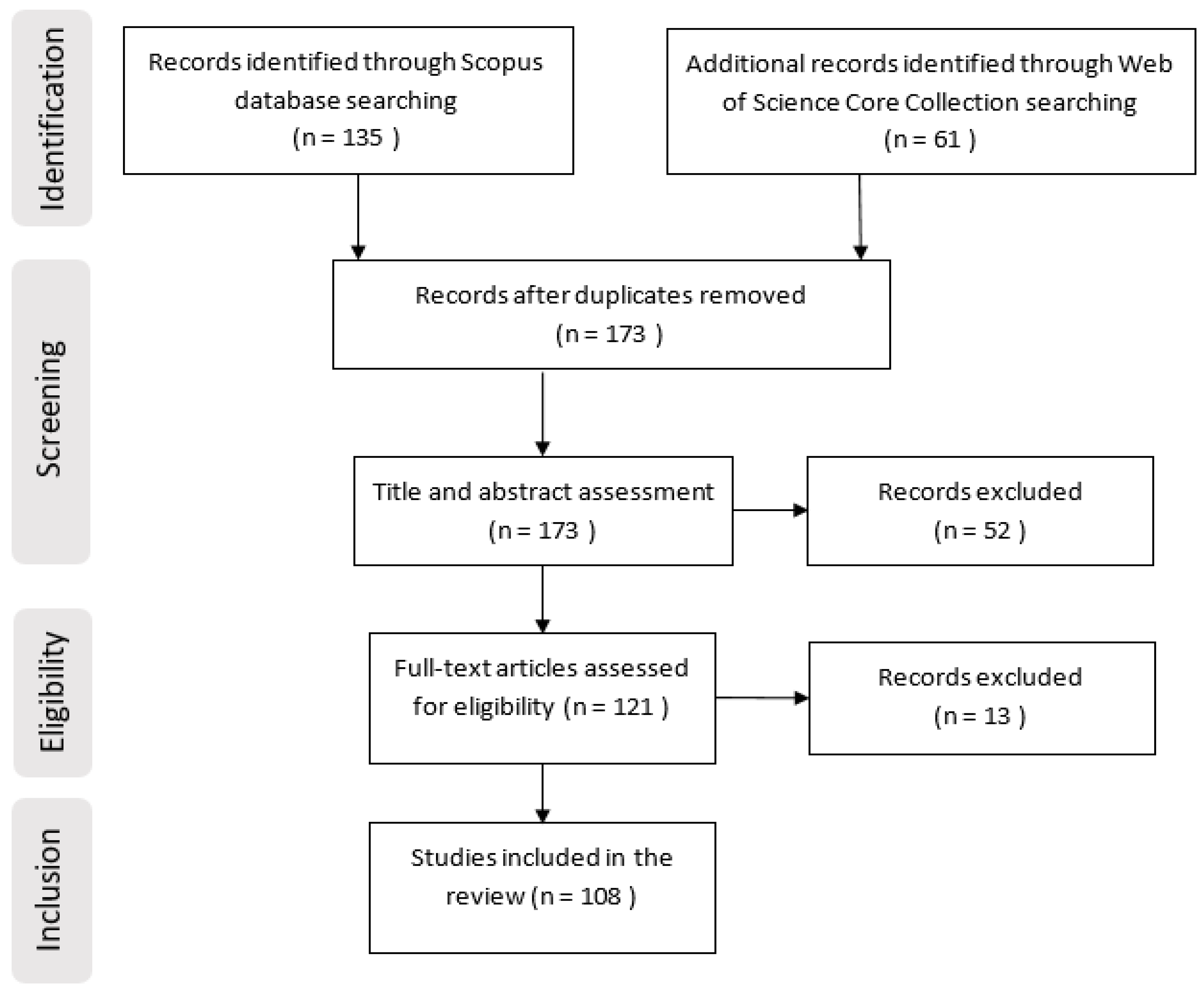
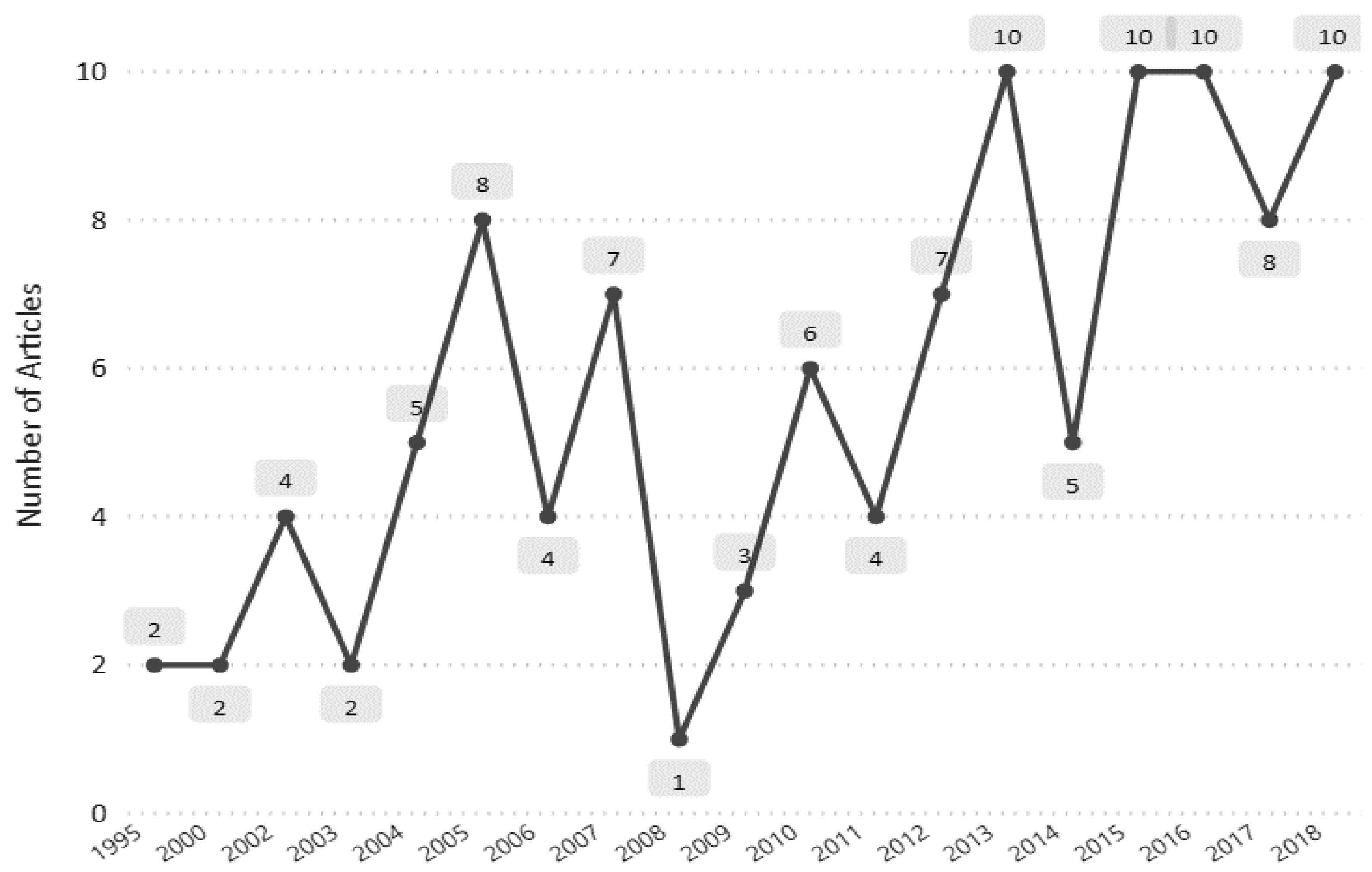
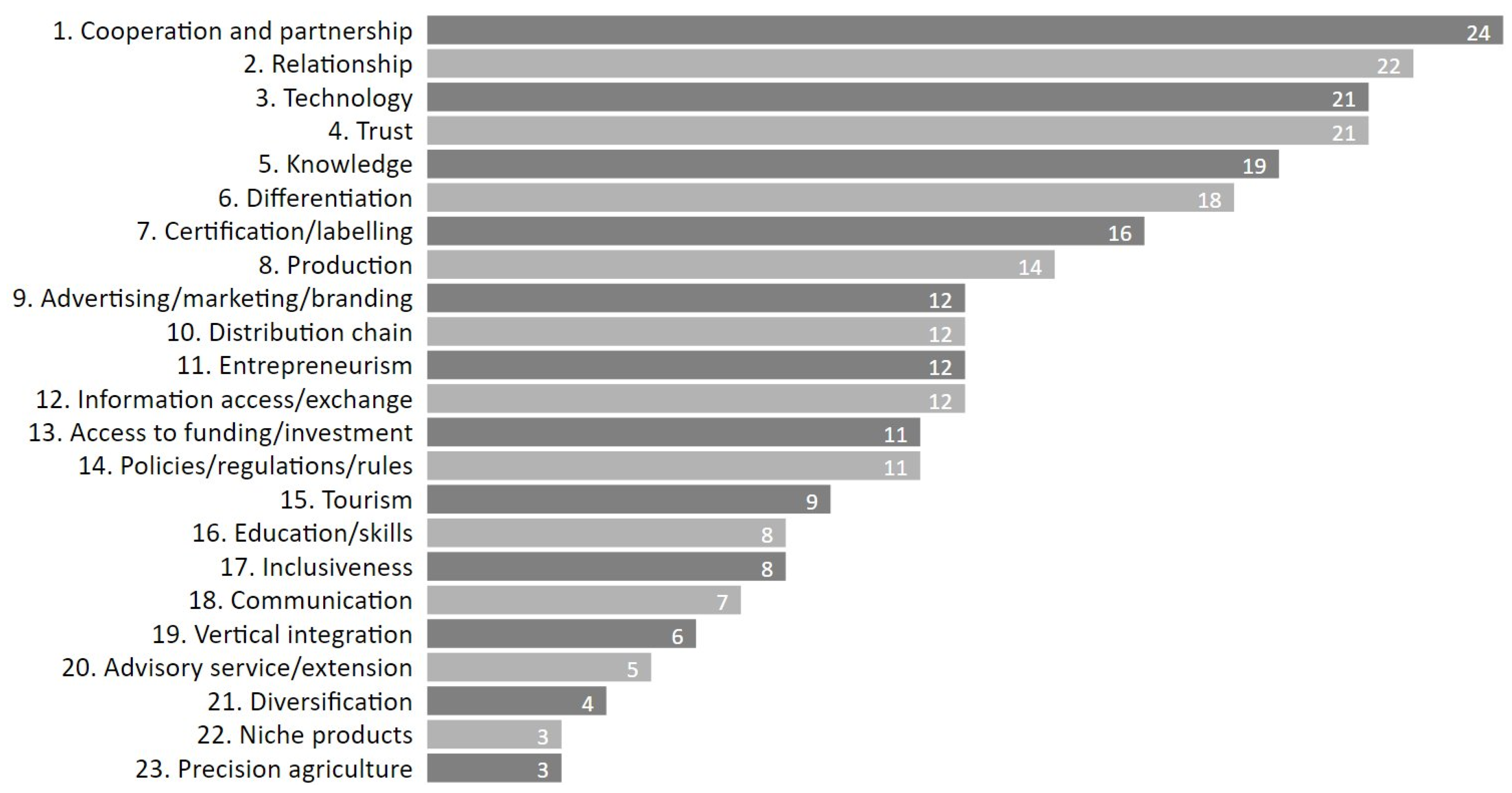
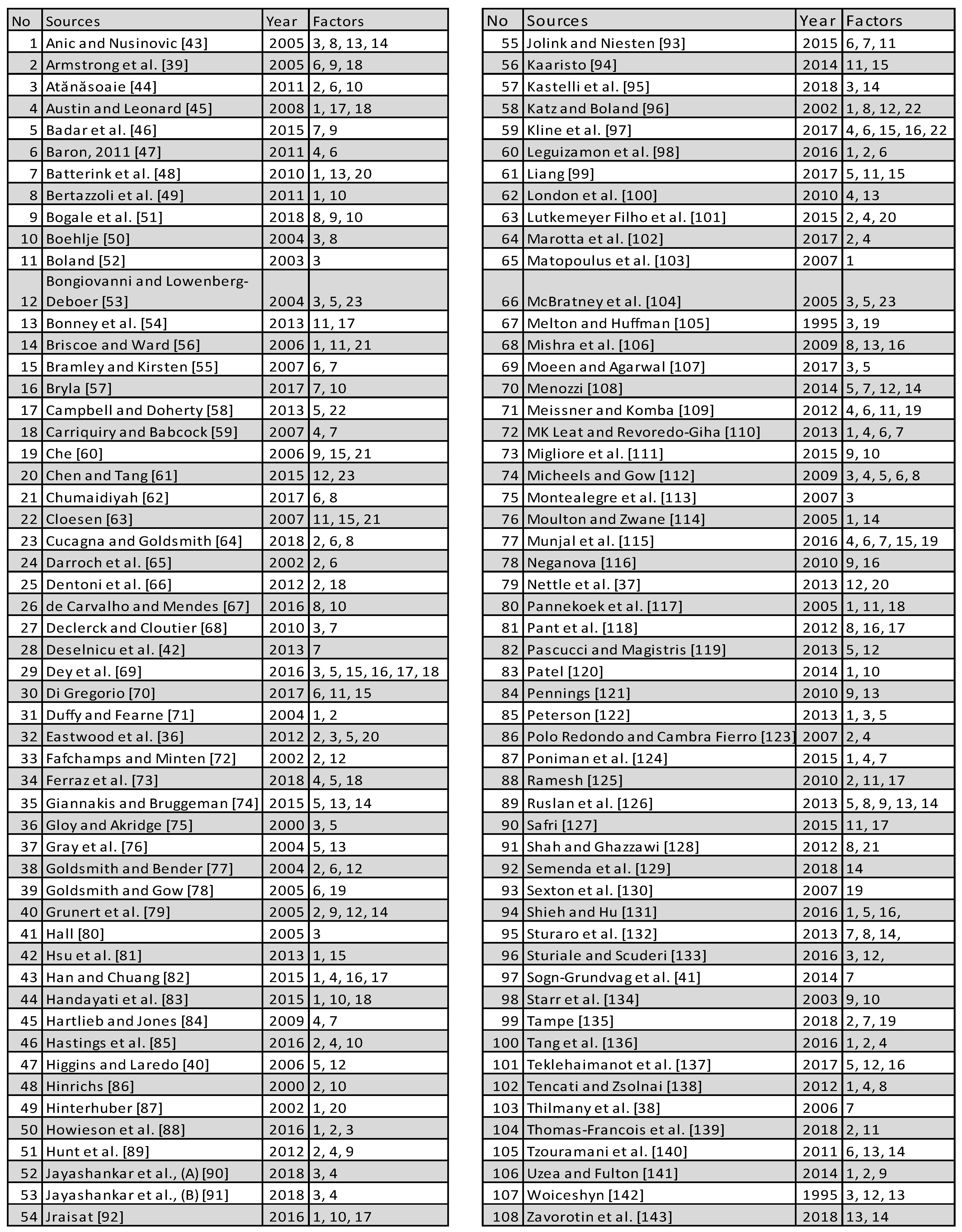
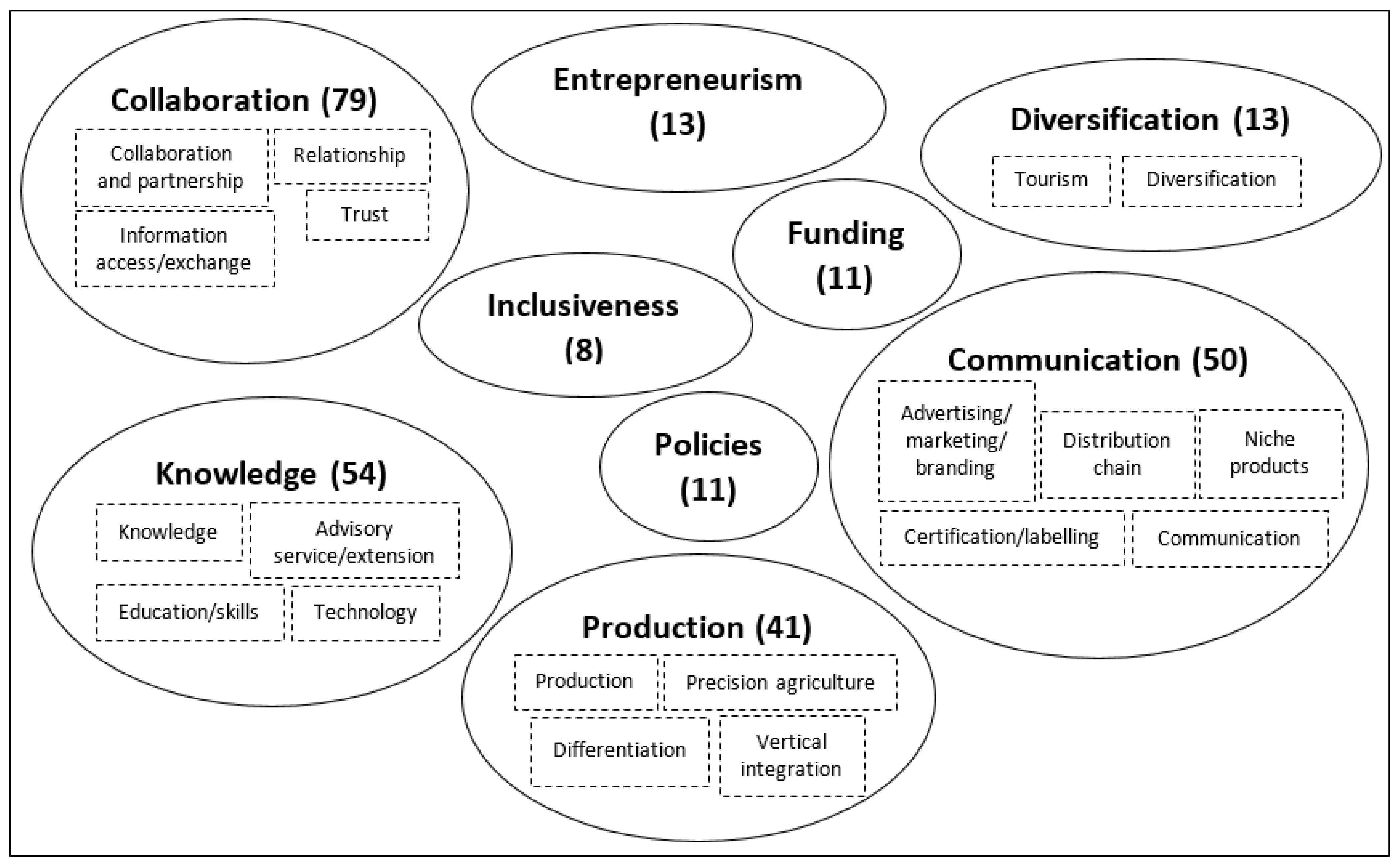
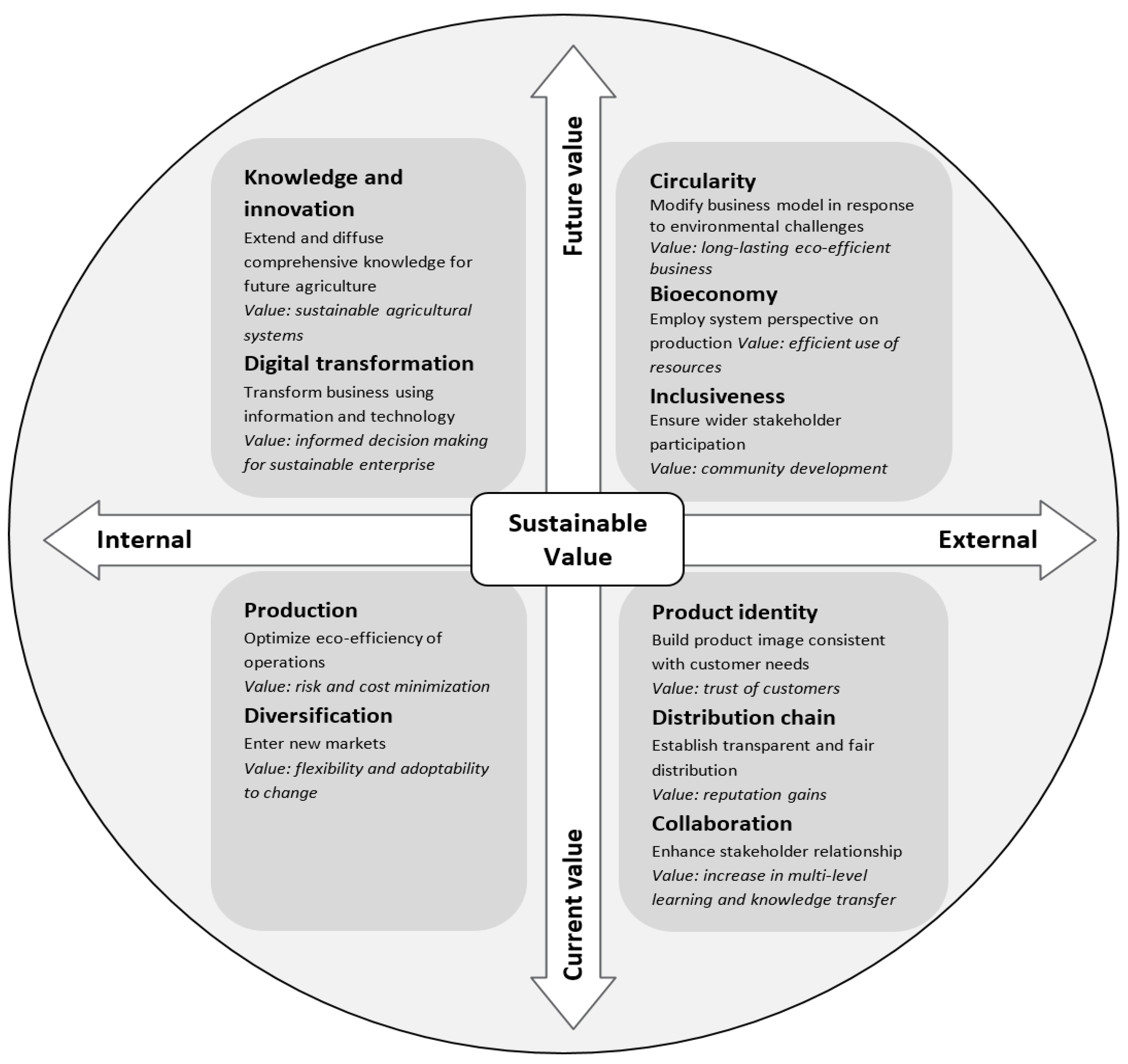
| Author | Definition |
|---|---|
| Amanor-Boadu [26] | Value-adding activity has to satisfy two conditions: (1) if one is rewarded for performing any activity that has traditionally been performed at another stage further down the supply chain; or (2) if one is rewarded for performing an activity that is discovered to be necessary, but has never been performed in the supply chain. |
| Coltrain et al. [24] | Value-adding is economically adding value to a product by changing its current place, time, and form characteristics to characteristics more preferred in the marketplace. |
| Ernst and Woods [27] | “Value-added agriculture” is a broad term encompassing many practices that increase the value of farm products. Value-added agriculture has come to describe practices as varied as agri-tourism activities that provide consumers with value from visiting a farm to large-scale processing endeavors that create mass-market retail food products from commodity crops. |
| Lu and Dudensing [28] | Value-added agriculture is a portfolio of agricultural practices that enable farmers to align with consumer preferences for agricultural or food products with form, space, time, identity, and quality characteristics that are not present in conventionally-produced raw agricultural commodities. Value-added agriculture can be characterized by farmers changing their position in the supply chain, creating closer or direct linkages between themselves and consumers, or changing production processes to alter or preserve certain intrinsic characteristics of their farm/ranch products. |
| USDA [29] | The agricultural commodity must meet one of the following five value-added methodologies:
|
| Womach [25] | Value-added refers most generally to manufacturing processes that increase the value of primary agricultural commodities. Value-added agriculture may also refer to increasing the economic value of a commodity through particular production processes, e.g., organic produce, or through regionally-branded products that increase consumer appeal and willingness to pay a premium over similar but undifferentiated products. |
| Database | Search Query | No. of Results |
|---|---|---|
| Scopus | TITLE-ABS-KEY (agro* OR agri* OR farm* OR agrar* OR horti*) AND TITLE-ABS-KEY ( ( value W/2 creat* ) OR ( value W/2 captur* ) ) | 135 |
| Web of Science Core Collection | TS=(value near/2 creat*) or (value near/2 captur*) AND TS=(agro* or agri* or farm* or agrar* or horti*) | 61 |
© 2020 by the authors. Licensee MDPI, Basel, Switzerland. This article is an open access article distributed under the terms and conditions of the Creative Commons Attribution (CC BY) license (http://creativecommons.org/licenses/by/4.0/).
Share and Cite
Sadovska, V.; Ekelund Axelson, L.; Mark-Herbert, C. Reviewing Value Creation in Agriculture—A Conceptual Analysis and a New Framework. Sustainability 2020, 12, 5021. https://doi.org/10.3390/su12125021
Sadovska V, Ekelund Axelson L, Mark-Herbert C. Reviewing Value Creation in Agriculture—A Conceptual Analysis and a New Framework. Sustainability. 2020; 12(12):5021. https://doi.org/10.3390/su12125021
Chicago/Turabian StyleSadovska, Vera, Lena Ekelund Axelson, and Cecilia Mark-Herbert. 2020. "Reviewing Value Creation in Agriculture—A Conceptual Analysis and a New Framework" Sustainability 12, no. 12: 5021. https://doi.org/10.3390/su12125021
APA StyleSadovska, V., Ekelund Axelson, L., & Mark-Herbert, C. (2020). Reviewing Value Creation in Agriculture—A Conceptual Analysis and a New Framework. Sustainability, 12(12), 5021. https://doi.org/10.3390/su12125021






